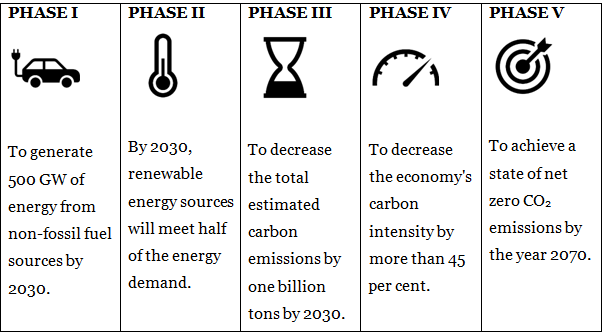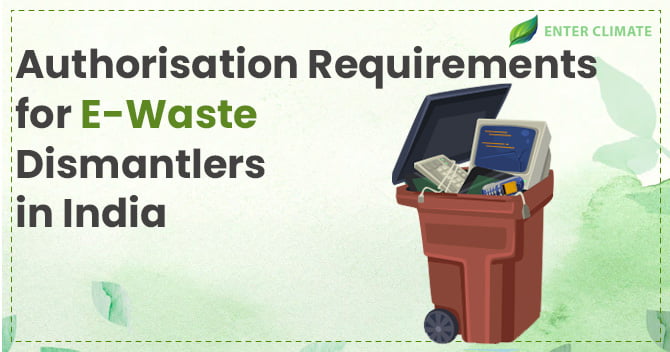Relevance of Five-point sustainability agenda (Panchamrits) for Entrepreneurs
 17 Apr, 2023
17 Apr, 2023 
During the 26th Conference of the Parties (“COP26”), India’s Prime Minister, Shri Narendra Modi, declared India’s intention to achieve net zero emissions by 2070, which is the main aim of the Five-point sustainability agenda (Panchamrits). While this commitment was seen as a significant step forward for India, some in the Western world felt it needed to be more ambitious and that it was coming too late. Indian PM Modi’s announcement of the five essential commitments, also known as “Panchamrits,” outlined a plan for a more environmentally sustainable India. These commitments offer tremendous opportunities for all sectors and have the potential to contribute to the growth of the Indian economy. This write-up will provide an overview of Modi’s commitments at COP26 and discuss the implications for India’s industry and economy.
Current situation concerning the Five-point sustainability agenda (Panchamrits)
India’s current take on climate Change can be summarised as follows:
- India has been progressing in combating climate change, with a new leap forward at COP26.
- India is currently ranked 5th in the world for installed renewable energy capacity.
- India has increased its renewable energy installed capacity by 226% in the past five years.
- The previous target to install 175 GW of renewable energy by 2022 has been extended due to the five new commitments made during COP26.
- These commitments present opportunities for the industry.
- In addition to the sustainability commitments, Prime Minister Modi also mentioned other important aspects related to climate change.
Five-point sustainability agenda (Panchamrits)

The five commitments made by PM Modi at COP26 are as follows:
- India’s target is to attain a net-zero emission state by 2070.
- India aims to generate 500 GW of non-fossil energy by 2030.
- India seeks to decrease the carbon intensity of its economy to 45% by 2030.
- India aims to meet 50% of its energy needs from renewable energy sources by 2030.
- India aims to reduce one billion tons of carbon emissions from the projected total emissions by 2030.
Detailed Five-point sustainability agenda (Panchamrits)
The first and second commitments of the Panchamrits aim to achieve two objectives:
- to increase non-fossil energy capacity to 500 GW by 2030 and
- to ensure that 50% of the energy demand is met through renewable energy sources.
This demonstrates a clear intent to transition to renewable energy in the long run and not achieve the new target of 500 GW of non-fossil energy through alternative means like nuclear power.
Currently, fossil fuels dominate India’s energy market, with renewable energy accounting for only 25.24% of the total installed generation capacity. India’s previous commitment was to establish a renewable energy capacity of 450 GW by 2030.
The third and fourth commitments made by India pertain to the country’s carbon emissions. India aims to reduce one billion tons of carbon emissions from the total projected emissions by 2030 and decrease the carbon intensity of its economy by no more than 45% until 2030.
India is the third-largest carbon emitter globally, but the per capita carbon emissions are lower than other industrialized countries.
India’s fifth commitment under the Five-point sustainability agenda (Panchamrits)is to attain the goal of Net Zero by 2070. These ambitious commitments will likely bring about a remarkable transformation in the Indian economy.
The concept of Net Zero will be reflected in businesses, and they will play a significant role in fulfilling these commitments. Many companies in India have announced their intentions to become net zero, and many are adopting environmentally friendly practices. Additionally, investors are keen on transparency regarding their partners’ environmental footprints and will scrutinize their current and future carbon footprints.
Declaration during the Five-point sustainability agenda (Panchamrits)
- March towards a greener Infrastructure – The Indian government’s efforts to promote green infrastructure, the country is still in the developmental stage. Some cities, such as Nagpur, have introduced green transportation methods like green buses, and several big cities are building new metro lines to make public transport more accessible. However, major cities in India still suffer from high pollution levels due to inadequate infrastructure. To address this issue, Prime Minister Modi has announced that the Indian railway system aims to achieve net-zero emissions by 2030 and reduce emissions by 60 million tons per year. This initiative will likely extend to other areas of infrastructure, and there is anticipation for more incentives and programs in this sector.
- Lifestyle for the Environment – The Indian government acknowledges that the key to a sustainable and environmentally friendly India is to raise awareness and make a sustainable lifestyle the norm. Therefore, the government plans to launch a Lifestyle for Environment (LIFE)[1] campaign to focus on improving sectors like fishing, agriculture, wellness, packaging, and housing. This campaign presents opportunities for industries that previously struggled to establish themselves in India, such as rooftop solar for residential buildings.
- Funding – In his speech at the COP26, Prime Minister Modi stated that developed countries were expected to provide climate finance of $1 trillion. However, he also acknowledged that the promises made regarding climate finance were empty. This implies that Prime Minister Modi recognizes that India cannot depend solely on developed countries to fulfil its five commitments. This aligns with his self-financing approach through programs such as “Make-in-India” and “Vocal-for-Local.” Therefore, the Indian government is consistently improving the business environment, particularly for foreign investors, by introducing schemes and amendments that promote ease of doing business, including tax incentives for manufacturing entities, fast-track processes for renewable projects, and expanding foreign direct investment.
Conclusion
The Indian government is taking initiatives to promote green infrastructure, increase awareness, and provide incentives for investors in the renewable energy sector. Foreign companies and investors can contribute to India’s sustainable development by strategically planning their investments while considering legal, financial, and tax aspects. With the Indian government committed to fulfilling its environmental targets by announcing a strong commitment through the five-point sustainability agenda (Panchamrits), there will be further incentives for the renewable energy sector. To maximize the benefits of these incentives, foreign investors should carefully plan their investments in India, considering all legal, financial, and tax-related considerations.













